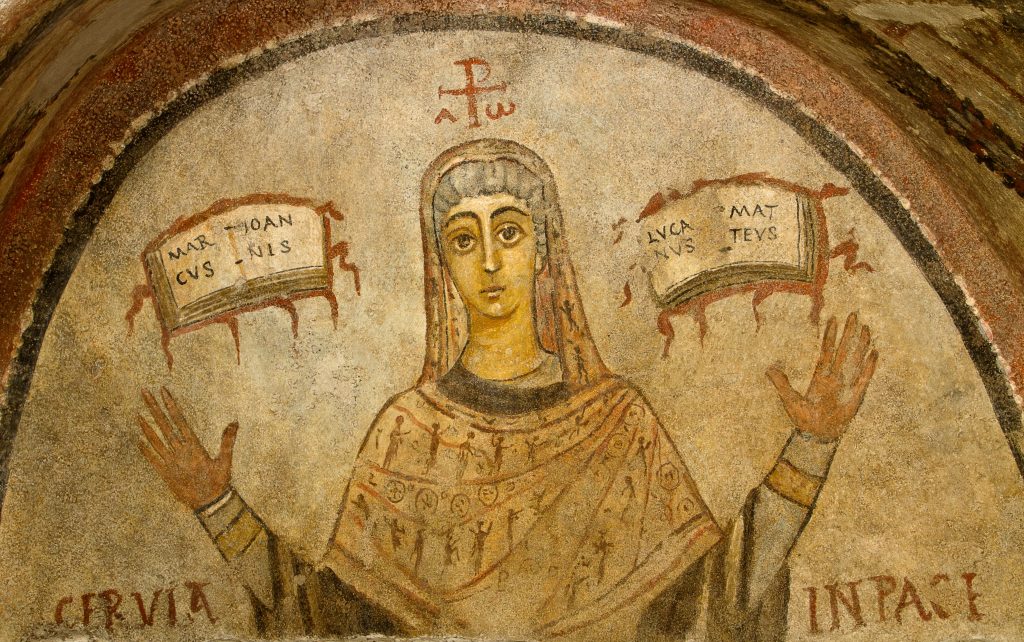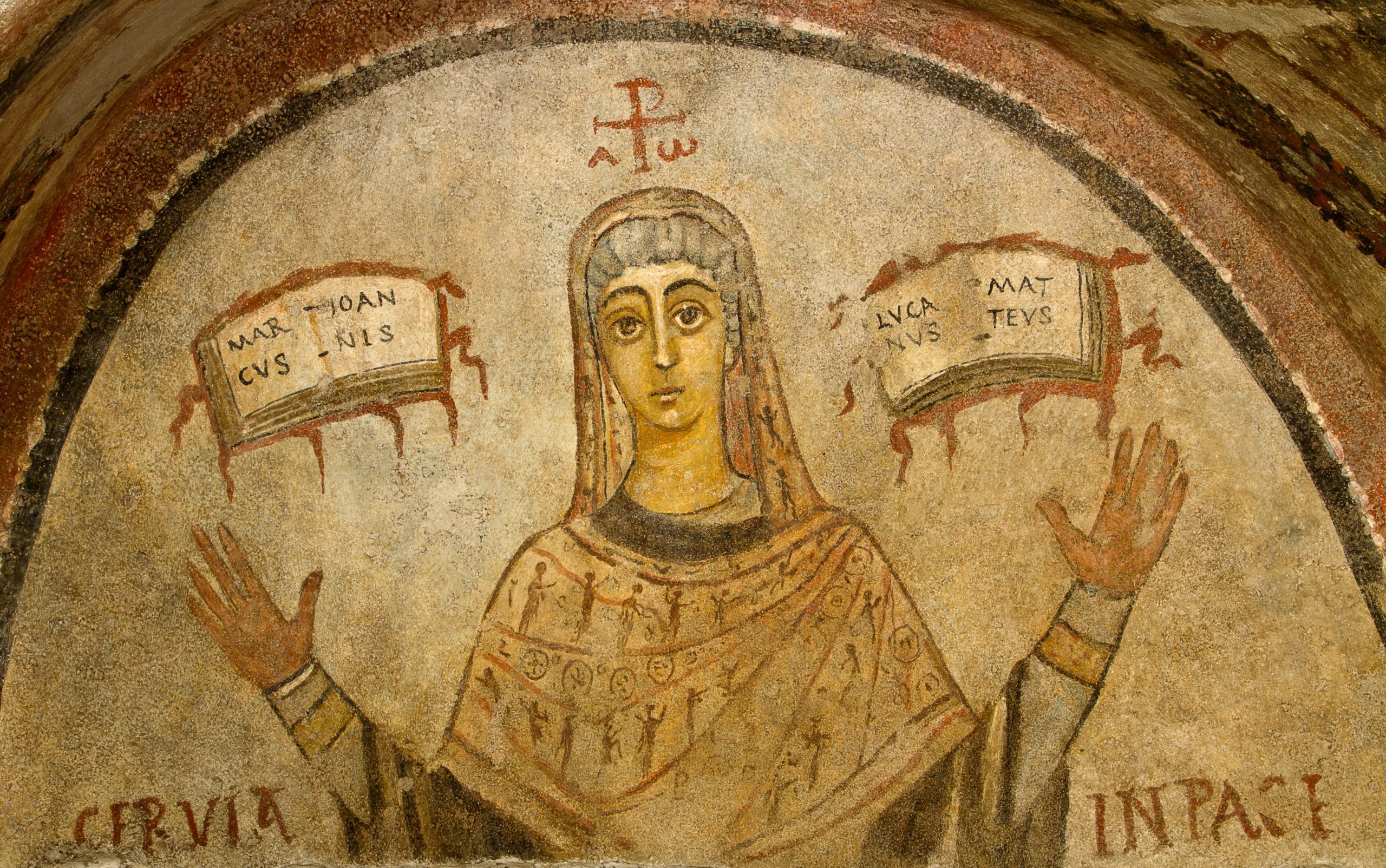


Bitalia and Cerula are women from the fifth or sixth century who are depicted in a fresco from the Catacombs of San Gennaro in Naples, Italy. This fresco was discovered in 1977 behind a marble slab, seemingly hiding it from view along with Cerula’s place of burial. Cerula was buried in a tomb under an ornamented arch, and Bitalia was buried nearby. We see their faces from the waist up, and both stand with outstretched arms in the orans pose. Flanking Cerula’s fresco are two of Paul and what seems to be Peter, who look over her. Affixed above both Cerula and Bitalia’s heads are the inscription alpha and omega and the Chi Ro, a symbol that represented Christ. Notably, neither of these symbols are portrayed with men in what Ally Kateusz calls “the so–called crypt of bishops” with the exception of Saint Gennaro, the martyr bishop after whom the catacombs were named.
Furthermore, floating above their hands are two codices opened to the four gospels. As funerary art depicts that which was most significant to the deceased person’s life, this signifies their intimacy with the gospel message. Kateusz argues that it is this element of the frescoes that points to them being bishops, as Christian art in this period usually associated books with bishops. The ordination ritual for a bishop also included (and still does) opening the gospel book over the bishop’s head.3 The Eucharist also appears to be on the table under Bitalia, possibly an altar, over which she hovers. This indicates she potentially is officiating the Lord’s supper, signaling her as a female presbyter.
In Christine Schenk’s work, she argues that other epigraphical evidence and exploration of contemporaneous women help us to understand their possible roles in the church. Though focusing on Bitalia, her scholarship applies both to Bitalia and Cerula. First, the title “presbyter” was one of many terms used in the early church to refer to a religious leader. This term was more formalized come the fifth century, sometimes indicating one who was ordained as a religious leader. Given historical opposition to female ordination, some dismissed these titles for women, arguing women were to be subordinate to men. However, deeper study provides evidence that this argument is incorrect.
Two women contemporaries of Bitalia and Cerula were also called presbyters. Kale of Centuripae, Sicily is mentioned as a presbytera, and notably is not mentioned with a husband. This title solely belongs to her. Leta from Tropea in Calabria is commemorated by her husband as presbytera on her tomb. While mentioned with her husband, he is given no title. Nonetheless, Pope Gelasius I of the fifth century prohibits the priesthood of women, expressing disdain that some encourage women to officiate the Eucharist and participate in male–only offices. That he was arguing against female priests acknowledges that some women indeed held these offices. Given the aforementioned art alongside the epigraphical and literary evidence, it is conceivable that Bitalia and Cerula served as priests in the early church.
Sources:
• Kateusz, Ally. “Cerula and Bitalia, Ordained Bishops,” 156–161. In Mary and Early Christian Women: Hidden Leadership. London: Palgrave Macmillan, 2019.
• Schenk, Christine. Crispina and Her Sisters: Women and Authority in Early Christianity. Minneapolis: Fortress Press, 2017.
Furthermore, floating above their hands are two codices opened to the four gospels. As funerary art depicts that which was most significant to the deceased person’s life, this signifies their intimacy with the gospel message. Kateusz argues that it is this element of the frescoes that points to them being bishops, as Christian art in this period usually associated books with bishops. The ordination ritual for a bishop also included (and still does) opening the gospel book over the bishop’s head.3 The Eucharist also appears to be on the table under Bitalia, possibly an altar, over which she hovers. This indicates she potentially is officiating the Lord’s supper, signaling her as a female presbyter.
In Christine Schenk’s work, she argues that other epigraphical evidence and exploration of contemporaneous women help us to understand their possible roles in the church. Though focusing on Bitalia, her scholarship applies both to Bitalia and Cerula. First, the title “presbyter” was one of many terms used in the early church to refer to a religious leader. This term was more formalized come the fifth century, sometimes indicating one who was ordained as a religious leader. Given historical opposition to female ordination, some dismissed these titles for women, arguing women were to be subordinate to men. However, deeper study provides evidence that this argument is incorrect.
Two women contemporaries of Bitalia and Cerula were also called presbyters. Kale of Centuripae, Sicily is mentioned as a presbytera, and notably is not mentioned with a husband. This title solely belongs to her. Leta from Tropea in Calabria is commemorated by her husband as presbytera on her tomb. While mentioned with her husband, he is given no title. Nonetheless, Pope Gelasius I of the fifth century prohibits the priesthood of women, expressing disdain that some encourage women to officiate the Eucharist and participate in male–only offices. That he was arguing against female priests acknowledges that some women indeed held these offices. Given the aforementioned art alongside the epigraphical and literary evidence, it is conceivable that Bitalia and Cerula served as priests in the early church.
Sources:
• Kateusz, Ally. “Cerula and Bitalia, Ordained Bishops,” 156–161. In Mary and Early Christian Women: Hidden Leadership. London: Palgrave Macmillan, 2019.
• Schenk, Christine. Crispina and Her Sisters: Women and Authority in Early Christianity. Minneapolis: Fortress Press, 2017.
Title of Art: (Fresco of Cerula)
Subjects: Cerula
Subject Century: fifth
Ritual Pose/Object: orans pose
Art Form: Fresco
Exhibit Institution: Catacombs of San Gennaro
Exhibit Location: Naples, Italy
VM Image #: 0117
Photographer: Wijngaards Institute for Catholic Research
